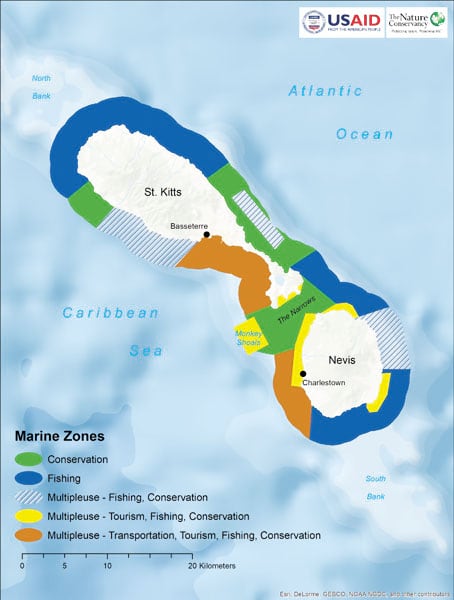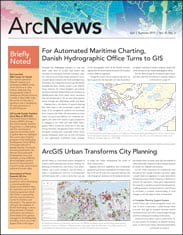Since its inception in 1951, The Nature Conservancy (TNC) has been a global leader in working with public and private partners to protect the lands and waters on which all life depends. Over the years, TNC’s mission has evolved to tackle the ever-more complex problems associated with climate change, all of which require more diverse actions. Yet protection of place remains key for the organization, as exemplified by its recent acquisition of the Jack and Laura Dangermond Preserve at Point Conception, California, where nearly 25,000 acres of unspoiled coastal habitat will be preserved. (Read more about this in ArcNews.)
To carry out its mission, TNC needs to know where to create protected areas that will sustain biodiversity and ecosystem services well into the future. Science-based conservation plans need to pinpoint the places where specific protection actions—such as land acquisitions or easements, encouraging indigenous land tenure, or creating no-trawl zones—need to be implemented to deliver the greatest return on investment for both people and nature. Thus, TNC is revolutionizing its approach to conservation, incorporating new principles, tools, and spatial data to inform its strategies.
The Recipe for Successful Conservation
Figuring out how to prioritize areas for conservation is like being a master chef. In the same way that chefs have to have sound knowledge of the main ingredients that make up particular dishes and then chop, cook, and spice them up in ways that elevate those ingredients to an integrated outcome, conservationists at TNC must be able to model and analyze the elements that make a place ripe for conservation and protection.
At TNC, the three main ingredients for protection action are as follows:
- The ecological or biophysical assets or values that TNC cares most about protecting
- The defined set of actions TNC would take to create and manage protected areas
- The factors or conditions that could affect TNC’s ability to have an impact and be successful
Making determinations about these considerations revolves around being able to decipher the spatial data that TNC’s scientists assemble using software and tools from Esri. To continue the metaphor, this is the taste testing that happens after all the ingredients are blended together.
In the early 2000s, TNC centered its strategic planning on the ecoregional maps it made, which showed the most important parts of the land- and seascape to protect. The intervening years, however, have seen a massive expansion in the amount and types of spatial data available, not to mention improvements in the models and tools that can be used to manipulate data.
That is why TNC is transforming systematic conservation planning into a process I call spatial action mapping. Spatial action mapping is all about picking the best places to act. It moves us from the traditional mapping of biodiversity assets—such as maps of species richness, ecosystem services, and wilderness areas—to maps of cost-effective and feasible actions. It takes us from the ingredients to the integrated outcome.

Below is the recipe for protection action. Applied well, the ingredients should deliver the maximum return on investment for conservation.
Step 1: Determine What’s Valuable
The first ingredient—identifying the assets and values to protect—can be added to this conservation recipe in several ways.
While recent literature has been dominated by ecologists and biogeographers who map natural assets, revealing places that support critical elements of biodiversity, these assets are not prioritizations in their own right. For protection, TNC considers two values to be the most critical: representation of biodiversity features, such as habitats and species, and resilience, particularly to climate change. TNC is in the midst of developing national and global maps of these values.
The maps are essential, but by themselves, they are insufficient for prioritizing action. That’s because these two ingredients—representation and resilience—are only two components of this recipe.
Step 2: Take Action
The next ingredient to be carefully folded into this recipe is knowing what concrete actions need to be taken in particular places.
TNC uses the International Union for Conservation of Nature’s (IUCN) definition of a protected area: “a clearly defined geographical space recognized, dedicated, and managed, through legal or other effective means, to long-term conservation of nature associated with ecosystem services and cultural values.” Given that protection entails the long-term conservation of a clearly defined space, TNC must take action to safeguard places that are critical for biodiversity or ecosystem services before they are converted for intensive human use—for agriculture, trawling, or infrastructure. In some cases, TNC also considers actions that involve partial or temporary protection, though the organization’s core business is long-term conservation.
Step 3: Heed Other Factors
Once TNC has identified valuable assets and is aware of the types of actions that need to be taken to protect them, the organization has to ensure that its investments in protection have the greatest benefit—the third ingredient in this recipe. For this, TNC analyzes two sets of factors: first, the potential impacts that conservation actions can have, and second, the conditions that would enable success.
Evaluating Potential Impacts
When evaluating the magnitude of the potential impact of protection actions, there are three factors that are important to consider:
- The risk that the area will eventually be converted, destroying the values that TNC is trying to protect
- The risk that ineffective management will lead to the degradation of those values
- The potential for several additional benefits to manifest from any given protection action, such as carbon sequestration or improvements in human health
Risk of conversion is driven by changes in land use that permanently degrade or eliminate the values that TNC is aiming to safeguard. Places that require certain types or high degrees of management may demand specific protection actions that are geared toward preventing the deterioration of values. And protecting places that have additional value—that help achieve other TNC conservation goals, for example—provides a greater return on investment.
Being able to analyze and map these risks and benefits, as well as how they impact the places that have healthy representation and are resilient, indicates where protection actions are likely to have the greatest overall effect.
Pinpointing Indicators of Success
The right circumstances greatly improve the likelihood that protection actions will be effective. The two critical indicators that TNC evaluates for this are, first, the probability of success, and second, whether the actions are compatible with cultural and social values.
Examining the likelihood of success includes evaluating the benefits of action, gauging political feasibility, and determining whether TNC can raise funding. When it comes to finding compatible cultural and social values, there are many indigenous and local communities throughout the world whose principles support the conservation of natural resources. The places where these communities live can embody an important enabling condition for the success of conservation protection actions.
Analyzing and mapping these two critical indicators ensures that TNC acts in places where it is most likely to succeed in achieving its goals.
Step 4: Blend the Ingredients
With all these ingredients in their various forms and flavors, TNC has the right recipe to ensure the meaningful, strategic, and effective deployment of protection activities around the globe so that critical lands and waters will be conserved well into the future.
Over the years, TNC has used a suite of tried and trusted tools to whip this recipe into successful servings of conservation. In particular, Marxan—a tool developed by my lab almost 20 years ago that can take data from any GIS software and assemble it for analysis—serves as the blender, while the Marxan user is the cook. Esri tools function as the taste tester, helping TNC conservationists visualize what might work and what probably won’t. All three—the blender, the cook, and the taste tester—must be good at what they do, or the recipe will fail.
At TNC, this recipe and its associated utensils yield maps for action that outline the highest-priority areas for protection. These maps are not only about the important places; they also outline precisely what actions must be taken—and for what reasons—to ensure that these spaces are protected. With these spatial action maps, TNC and its partners are leading the way in conservation action prioritization around the globe.


